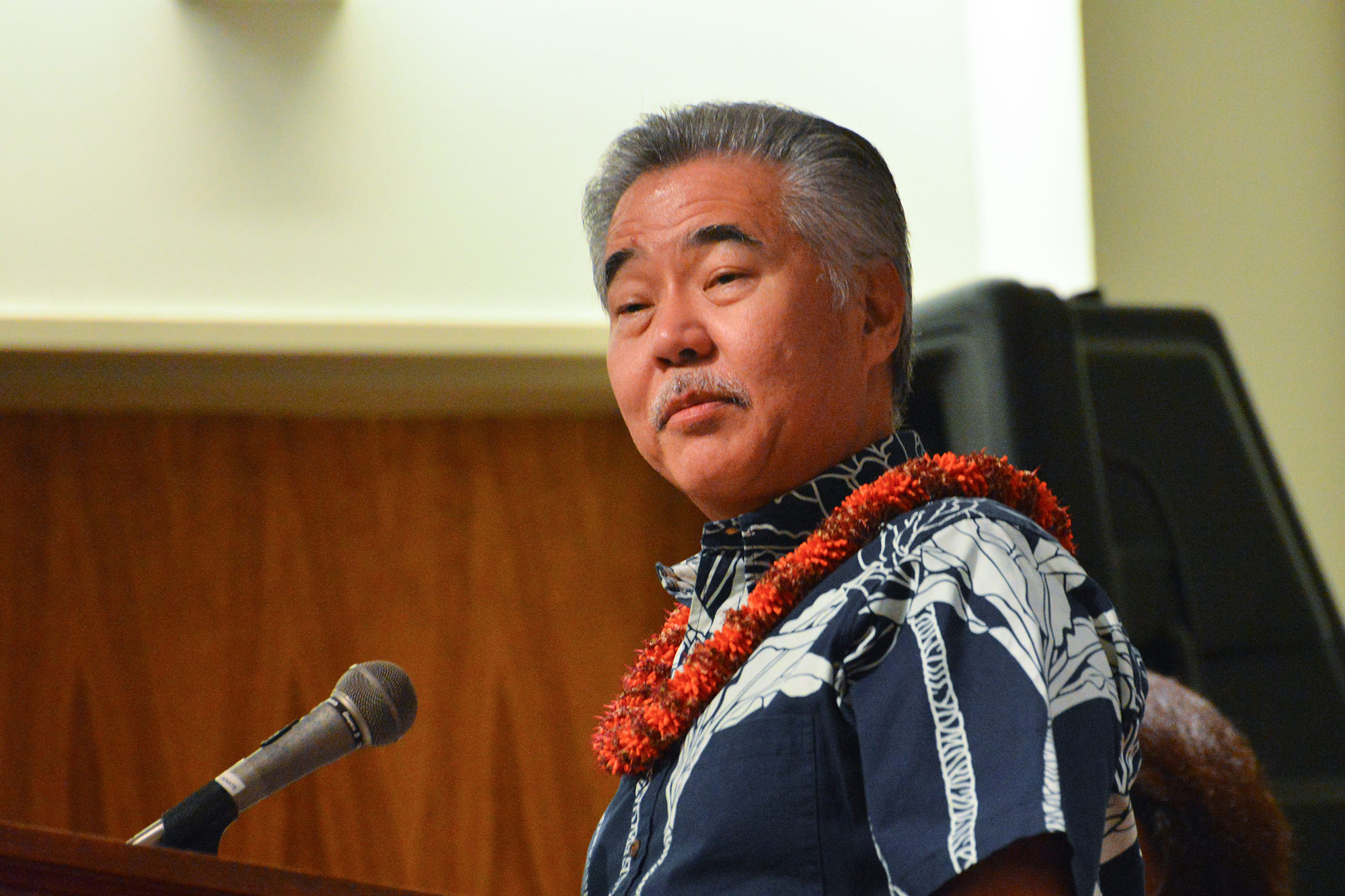After nearly a week of overwhelming criticism of his idea to cut many state employees’ pay by 20 percent because of falling tax revenues, Gov. David Ige said during a news conference Monday, “I just really want to assure everyone that salary reductions would be the last resort.
“We’d be looking at all available options of funds, rainy day funds, support from the federal government in different ways before we look at salary reductions,” Ige told reporters.
“We certainly are working with our congressional delegation about funds to support the state and recover lost revenues, and those funds and those grants would be important because they would allow us to maintain employment and not have to look at reductions in salaries,” Ige added.
Late last week, state officials informed union leaders the implementation date of the potential salary cuts has been delayed by at least one month, to June 1 instead of May 1.
HSTA President Corey Rosenlee and other public union leaders said the state has other options, noting the state’s cash surplus at the end of last fiscal year and the “rainy day” fund equal more than $1 billion.
“HSTA and other public sector unions have made it clear to the governor that this will exacerbate our weakening economy, hurt government employees, and potentially prolong this crisis,” Rosenlee said. “We stand united and will not accept the governor’s plan without exploring every last alternative to keep these harmful cuts from happening.”
Congress, White House contemplate billions in aid for states and counties
The White House and Congress Monday tried to design another giant bailout package aimed at combating the coronavirus pandemic’s economic and health fallout, The Washington Post reported.
The new package would amount to roughly $470 billion in new spending, with $370 billion directed to small businesses, $75 billion going to hospitals, and $25 billion set aside for testing.
Congressional aides cautioned, however, that talks were ongoing and details remained in flux.
Democrats insisted Monday they had not abandoned their push for relief for state and local governments whose budgets have been hollowed out by the pandemic, but Republicans and administration officials continued to reject those demands.
"It's important for the feds to support our efforts to fund the stuff we do," Gov. Charlie Baker (R, Massachusetts) said on CBS News. "If we're laying off tens of thousands of people at exactly the time when they want to reopen the economy, we're going to be swimming against the current they're trying to create."
President Donald Trump said Sunday evening he supports backstopping states and local governments at "another time." White House officials told Axios they envision such a package weeks or months from now.
Gov. Andrew Cuomo (D, New York) said at a press briefing Monday that his state is projecting it will need to cut funding for schools, local governments and hospitals by 20 percent if it doesn't get relief money from the federal government in the next coronavirus bill.
In Washington, D.C. Friday, U.S. Senator Brian Schatz (D, Hawaii), U.S. Senator Mazie Hirono (D, Hawaii) and 31 of their colleagues called on the treasury secretary and the Republican-controlled Senate to set aside billions of dollars in funding for state, local, and tribal governments to receive in the next COVID-19 emergency funding package.
“On behalf of our state, local, and tribal governments, it is essential that you include robust, dedicated, and flexible funding to all units of state and local government in the next interim emergency coronavirus package to support their ongoing efforts in the fight against this pandemic. Not only are these public servants on the front line of the immediate response effort, they are also major employers navigating unprecedented declines in revenue just as the need for their services hits an all-time high. We can and we must work together to get this essential funding to our local partners as quickly as possible,” the senators wrote in a letter to Treasury Secretary Steve Mnuchin and Senate Majority Leader Mitch McConnell.
Ige not easing stay-at-home restrictions, as Oahu reports no new cases Monday
On Monday, Oahu reported no new cases for the first time since the coronavirus appeared in the islands, an indication that the state’s stay-at-home order is stopping the spread of the virus.
Hawaii Island and Maui each reported two new cases on Monday, according to state health officials.
The governor said he’s going to extend the stay-at-home order beyond April 30, while easing some restrictions and potentially deeming more businesses “essential,” allowing them to reopen.
“We are considering all of the mandates and looking at where we are as a community and where we are as a state,” Ige said.
Ige and Lt. Gov. Josh Green announced that Hawaii would reopen in phases, but dates and other details still haven't been set.
“It really boils down to how safe we are from seeing significant spread," said Green, who's also an emergency department physician. "There’s discussion obviously about how careful we’re going to have to be with our travelers coming to Hawaii, but we defer those conversations into the future, because we don’t absolutely know that we’ve stamped out this virus.”
Early models predicted as many as 4,479 people in Hawaii could die of the pandemic, but only 10 have died in the islands so far, Green added.
State Health Director Bruce Anderson, in a media briefing Monday afternoon, said, “Our numbers are excellent. We have the fewest cases of disease and the fewest deaths in the country over at least a one-week period. It changes from day to day, of course, but right now we’re looking pretty good.”
Asked why Hawaii is not beginning to reopen government and business operations when other states that are in worse shape are starting to open up, Anderson said, “We need to make sure that we have the situation under control for a sustained period of time before we start relaxing controls."

